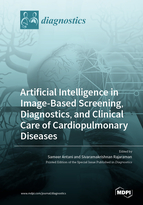Artificial Intelligence in Image-Based Screening, Diagnostics, and Clinical Care of Cardiopulmonary Diseases
A special issue of Diagnostics (ISSN 2075-4418). This special issue belongs to the section "Machine Learning and Artificial Intelligence in Diagnostics".
Deadline for manuscript submissions: closed (15 October 2022) | Viewed by 34666
Special Issue Editors
Interests: machine learning; artificial intelligence; medical image analysis; image informatics; multimodal data analysis; data science
Special Issues, Collections and Topics in MDPI journals
Interests: machine learning; artificial intelligence; computer vision; medical image analysis; data science; biomaterial-associated infections; music therapy
Special Issues, Collections and Topics in MDPI journals
Special Issue Information
Dear Colleagues,
Cardiothoracic and pulmonary diseases are a significant cause of mortality and morbidity worldwide, and additional focus has been brought about by the COVID-19 pandemic. According to the recent American Lung Association report, more than 228,000 people will be diagnosed with lung cancer in the United States alone this year, with the rate of new cases varying by state. Further, heart disease is indiscriminate in ethnic and racial origin in causing mortality. Additionally, infectious diseases, such as tuberculosis (TB) often coupled with human immunodeficiency virus (HIV) comorbidity, are found with drug-resistant strains that greatly impact treatment pathways and survival rates.
Screening, diagnosis, and management of such cardiopulmonary diseases has become difficult owing to the limited availability of diagnostic tools and experts, particularly in low and middle income regions. Early screening and accurate diagnosis and staging of cardiopulmonary diseases could play a crucial role in treatment and care, and potentially aid in reducing mortality.
Radiographic imaging methods such as computed tomography (CT), chest-X-rays (CXRs), and echo ultrasound are widely used in screening and diagnosis. Research on using image-based artificial intelligence (AI) and machine learning (ML) methods can help in rapid assessment, serve as surrogates for expert assessment, and reduce variability in human performance.
Through this Special Issue, “Artificial Intelligence in Image-Based Screening, Diagnostics, and Clinical Care of Cardiopulmonary Diseases”, we aim to highlight primary research studies and literature reviews focusing on novel AI/ML methods and their application in image-based screening, diagnosis, and clinical management of cardiopulmonary diseases. We hope that the Special Issue will help convey the state of the art in AI that exhibits the potential to make a significant contribution to an important global health challenge.
We invite leading researchers to submit their previously unpublished and novel research in this area.
Dr. Sameer Antani
Dr. Sivaramakrishnan Rajaraman
Guest Editors
Manuscript Submission Information
Manuscripts should be submitted online at www.mdpi.com by registering and logging in to this website. Once you are registered, click here to go to the submission form. Manuscripts can be submitted until the deadline. All submissions that pass pre-check are peer-reviewed. Accepted papers will be published continuously in the journal (as soon as accepted) and will be listed together on the special issue website. Research articles, review articles as well as short communications are invited. For planned papers, a title and short abstract (about 100 words) can be sent to the Editorial Office for announcement on this website.
Submitted manuscripts should not have been published previously, nor be under consideration for publication elsewhere (except conference proceedings papers). All manuscripts are thoroughly refereed through a single-blind peer-review process. A guide for authors and other relevant information for submission of manuscripts is available on the Instructions for Authors page. Diagnostics is an international peer-reviewed open access semimonthly journal published by MDPI.
Please visit the Instructions for Authors page before submitting a manuscript. The Article Processing Charge (APC) for publication in this open access journal is 2600 CHF (Swiss Francs). Submitted papers should be well formatted and use good English. Authors may use MDPI's English editing service prior to publication or during author revisions.
Keywords
- Artificial intelligence
- Image-based screening and diagnostics
- Computer-aided diagnosis
- Machine learning and deep learning
- Cardiothoracic and pulmonary diseases
- Radiographic imaging
- Computed tomography (CT)
- Chest-X-rays (CXRs)
- Echo ultrasound








